A coverable issue (e.g., Story, requirement) may be covered by one or multiple Tests. In fact, the test coverage status of a given issue goes way further than the basic covered/not covered information; it takes into account your test results.
As soon as you start running your Tests, the individual test result may be one of many and it will be very specific to your use case.
To make your analysis even more complex, you may be using sub-requirements, for example, and executing related Tests.
Requirements may be validated directly or indirectly through related sub-requirements and associated Test cases.

How do all these factors contribute to the calculation of a coverage status? How is the status of a Test evaluated?
Let’s start by detailing the different possible values Test, Test Step and coverage statuses. Then, we’ll see how they’ll impact on the calculation of the coverage status of a issue in some specific version or Test Plan.
When talking about statuses, we may be talking about statuses of requirements, Tests, Test Runs and Test Steps.
The status (i.e., test coverage status) of a coverable issue depends on the status of its "related" Tests.
The status of a Test depends on the status of its "related" Test Runs, which in turn depend on the recorded Test Step statuses for each one of them.
When we're speaking about the status associated with a requirement or with a Test (and even with a Test Set), we may be talking about different things:
In this page, we're referring to #1, i.e., the status of the entities based on the executions made in some context. |
The status of a Test tells you information about its current consolidated state (e.g. latest record result, if existent). Was it is executed? Successfully? In which version?
Thus, when speaking about the "status of a Test", we need to give it additional context (e.g. "In which version?") since it depends on "where" and how you want to analyze it.
The status of a Test indicates its "latest state" in some given context (e.g. for some version, some Test Plan and/or in some Test Environment). |
Xray provides some built-in Test statuses (which can’t be modified nor deleted):
Test status | Final status? | Test Coverage Status mapped to |
|---|---|---|
| PASS | yes | OK |
| FAIL | yes | NOK |
| TODO | no | NOTRUN |
| ABORTED | yes | NOTRUN |
| EXECUTING | no | NOTRUN |
| custom | custom | OK, NOK, NOTRUN or UNKNOWN |
The status (i.e., result) of a Test Run is an attribute of the Test Run (a “Test Run” is an instance of a Test and is not a Jira issue) and is the one taken into account to assess the coverage status of the coverable issue.
Creating new Test (Run) statuses may be done in the Global Settings: Test Statuses configuration section of Xray.
When creating/editing a Test status, we have to identify the Test Coverage Status to which we want this Test status to map.
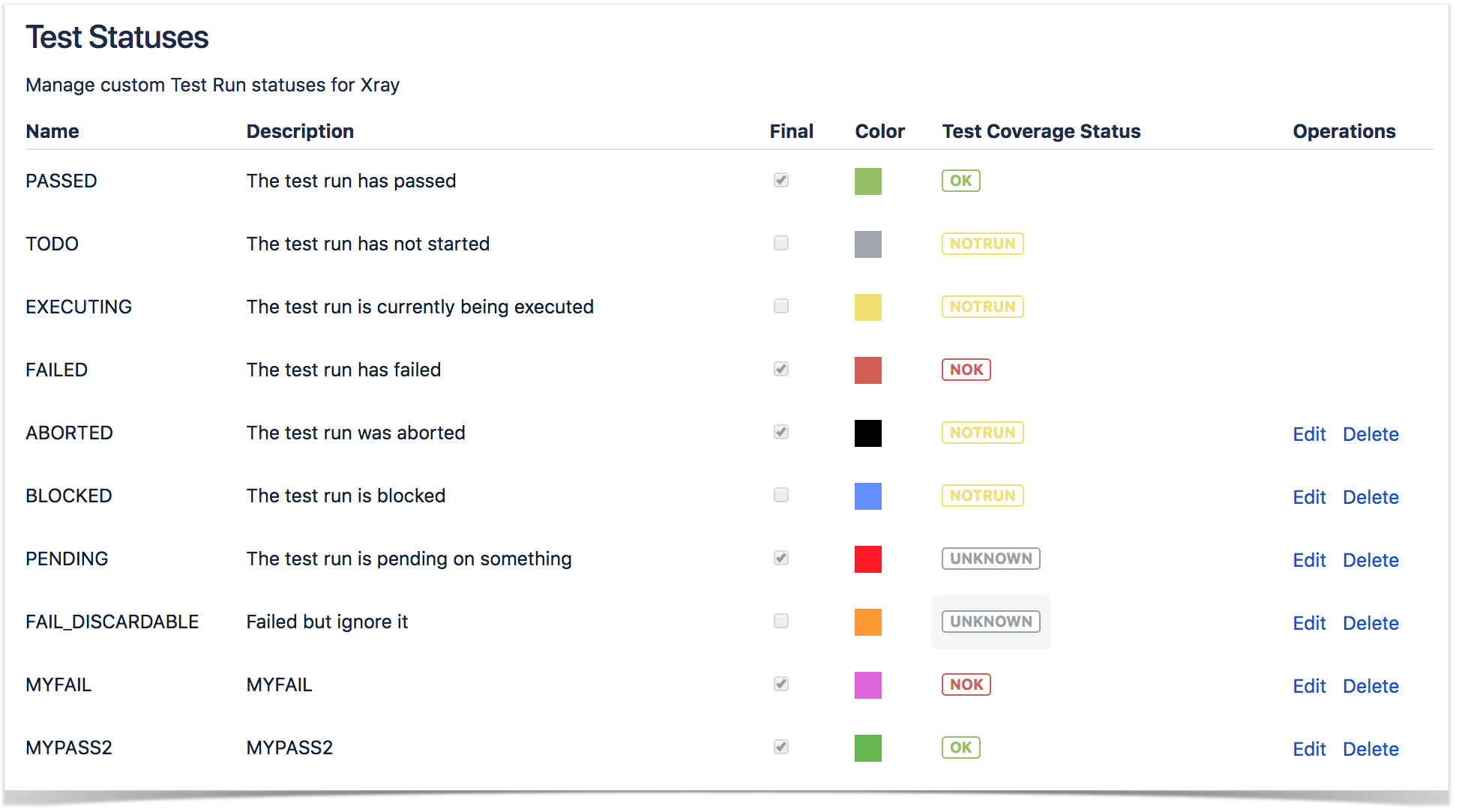
One important attribute of a Test status is the “final” attribute. If Final Statuses have precedence over non-final flag is enabled, then Xray will give priority to final statuses when calculating the status of a Test. In other words, if you have a Test currently in a final status (e.g., PASS, FAIL) and you schedule a new Test Run for it, then this Test Run won't affect the calculation of the status of the Test.
You may use this if you prefer to take into account only the last final/complete recorded result and want to discard Test Runs that are in an intermediate status (e.g., EXECUTING, TODO).
The status of a Test Step indicates the result obtained for that step for some Test Run.
| Statuses reported at Test Step level will contribute to the overall calculation of the status of the related Test Run. |
Xray provides some built-in Test Step statuses (which can’t be modified nor deleted).
Test Step status | Test status |
|---|---|
| PASS | PASS |
| TODO | TODO |
| EXECUTING | EXECUTING |
| FAIL | FAIL |
| custom | custom |
Creating new Test Step statuses may be done in the Global Settings: Test Step Statuses configuration section of Xray.
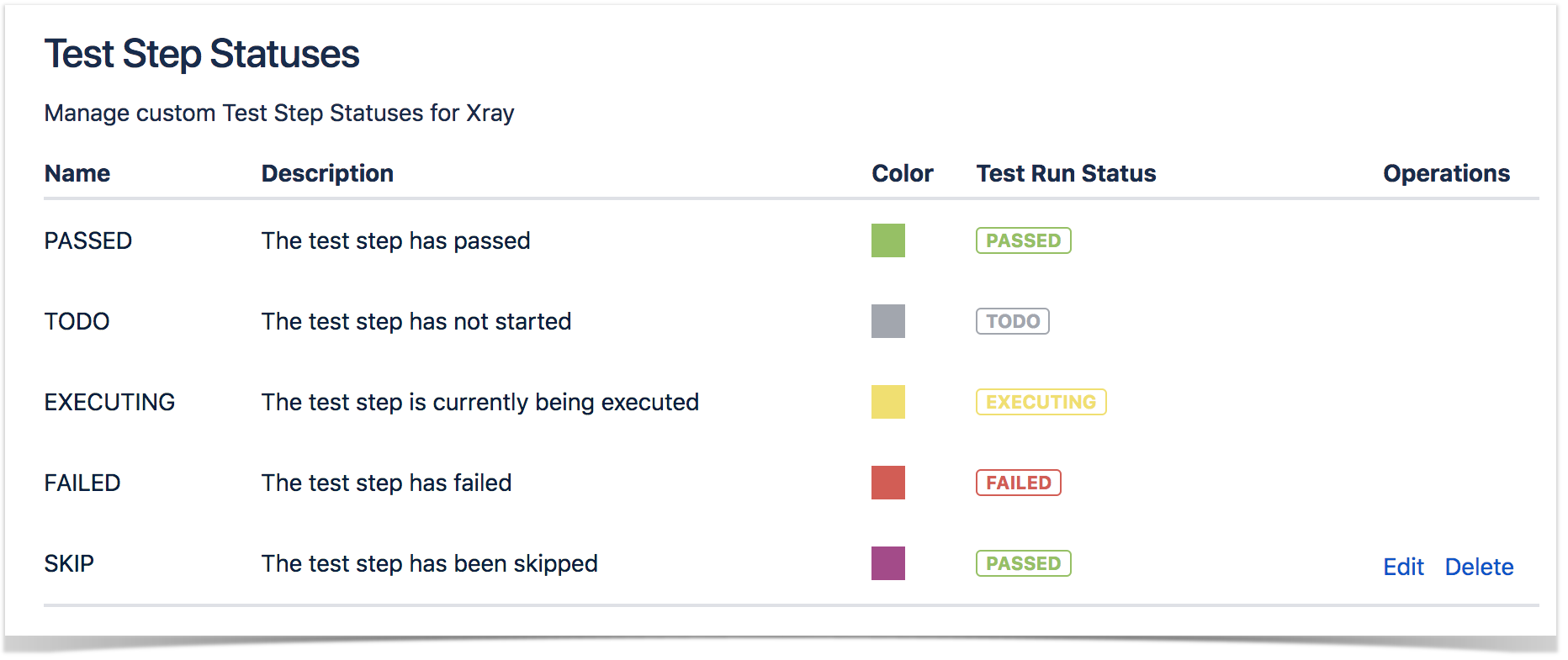
When creating/editing a Test Step status, we have to identify the Test status to which we want this step status to map.
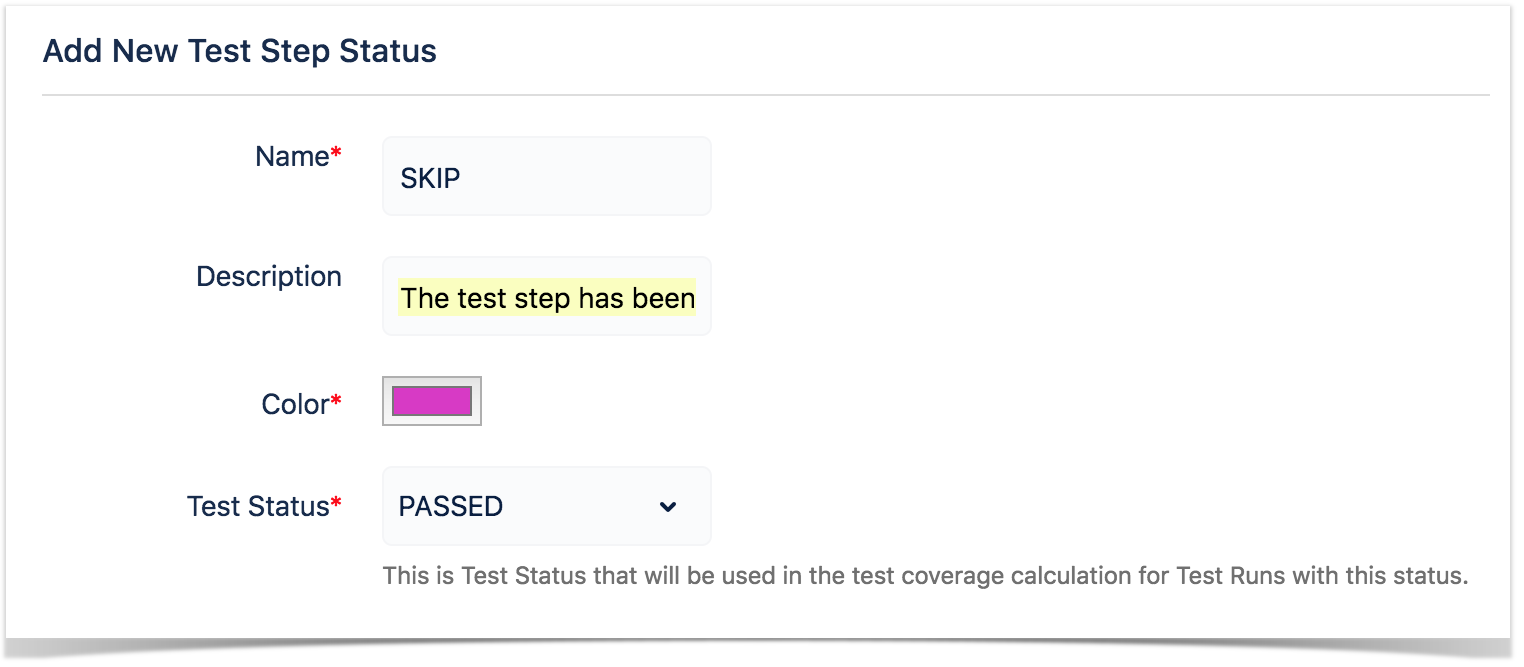
Note that native Test Step statuses can’t be modified nor deleted.
The (coverage) status of a coverable issue tells you information about its current state, from a quality perspective. Is it covered with test cases? If so, has it been validated successfully? In which version?
Thus, when speaking about the "status of a requirement/Story", for example, we need to give it additional context (e.g., "In which version?") since it depends on "where" and how you want to analyze it.
The (coverage) status of a coverable issue indicates its coverage information along with its "state", depending on the results recorded for the Tests that do validate it. This status is evaluated in a given context (e.g., for some version, some Test Plan and/or in some Test Environment). |
In Xray, for a given coverable issue, considering the default settings, its coverage status may be:
It’s not possible to create custom Test Coverage statuses.
To calculate an issue coverage status for a specific system version, we “just” need to take into account the status of the related Tests for that same version. We’ll come back to this later on.
The status of a given Test Run is an attribute that is often calculated automatically based on the respective recorded step statuses. You can also enforce a specific status for a Test Run, which in turn may implicitly enforce specific step statuses (e.g., setting a Test Run as "FAIL" can set all steps as "FAIL").
This calculation is made by following these rules:
The order of the steps is irrelevant for the purpose of the overall Test Run status value.
Consequences:
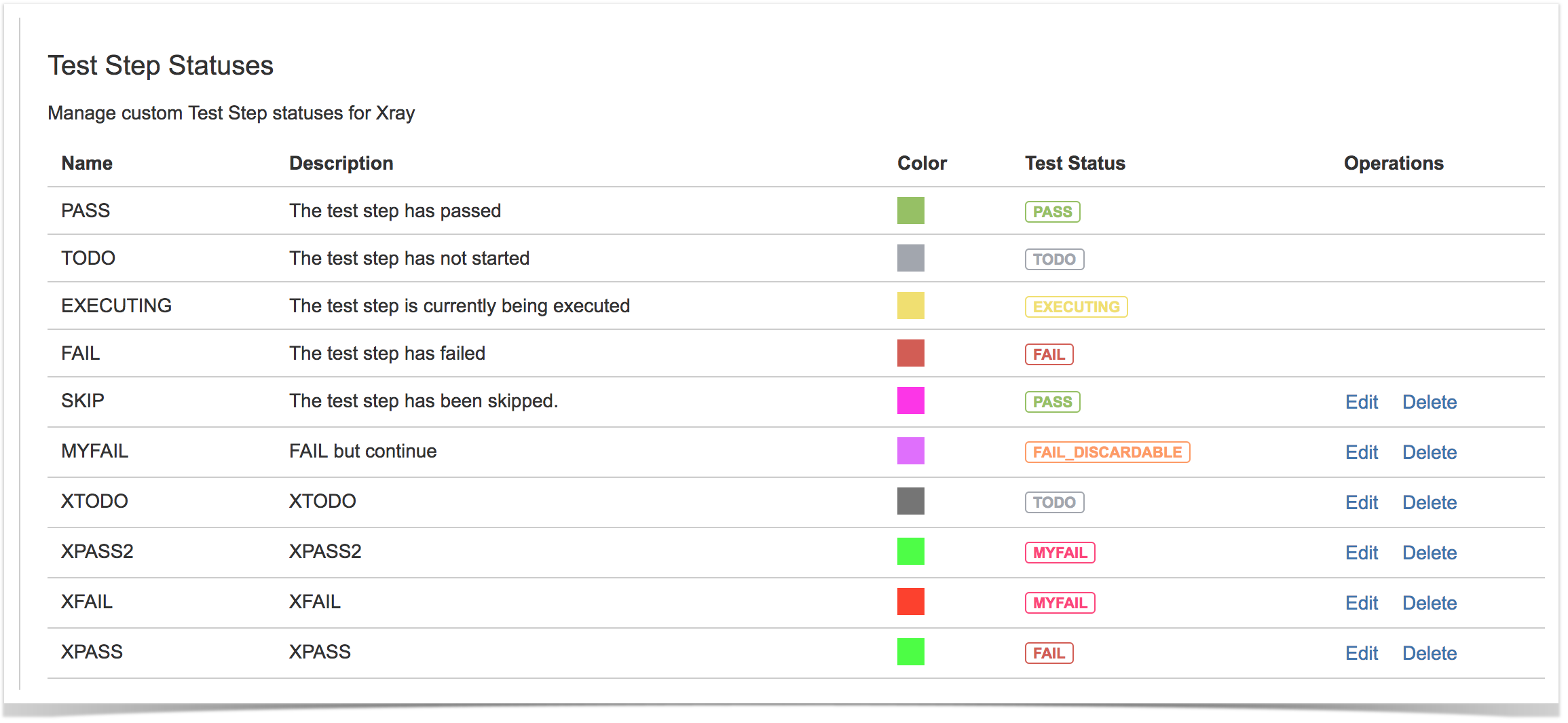
The following table provides some examples given the Test Step Statuses configuration shown above.
Example # | Statuses of the steps/contexts (the order of the steps/contexts is irrelevant) | Calculated value for the status of the Test Run | Why? |
|---|---|---|---|
| 1 |
| PASS | All steps are PASS, thus the joint value is PASS |
| 2 |
| EXECUTING | At least one step status (i.e. TODO) is mapped to a non-final Test status |
| 3 |
| FAIL | One of the step statuses (i.e. FAIL) has higher ranking than the other ones |
| 4 |
| FAIL | Since one of the steps is FAIL, then the run will be marked as FAIL. |
| 5 |
| FAIL | Since one of the steps is FAIL, then the run will be marked as FAIL. |
| 6 |
| FAIL | All mapped statuses map to a test status that in turn is associated to "NOK". Since one of them is FAIL, then the run will be marked as FAIL. |
Let's consider the following configuration.

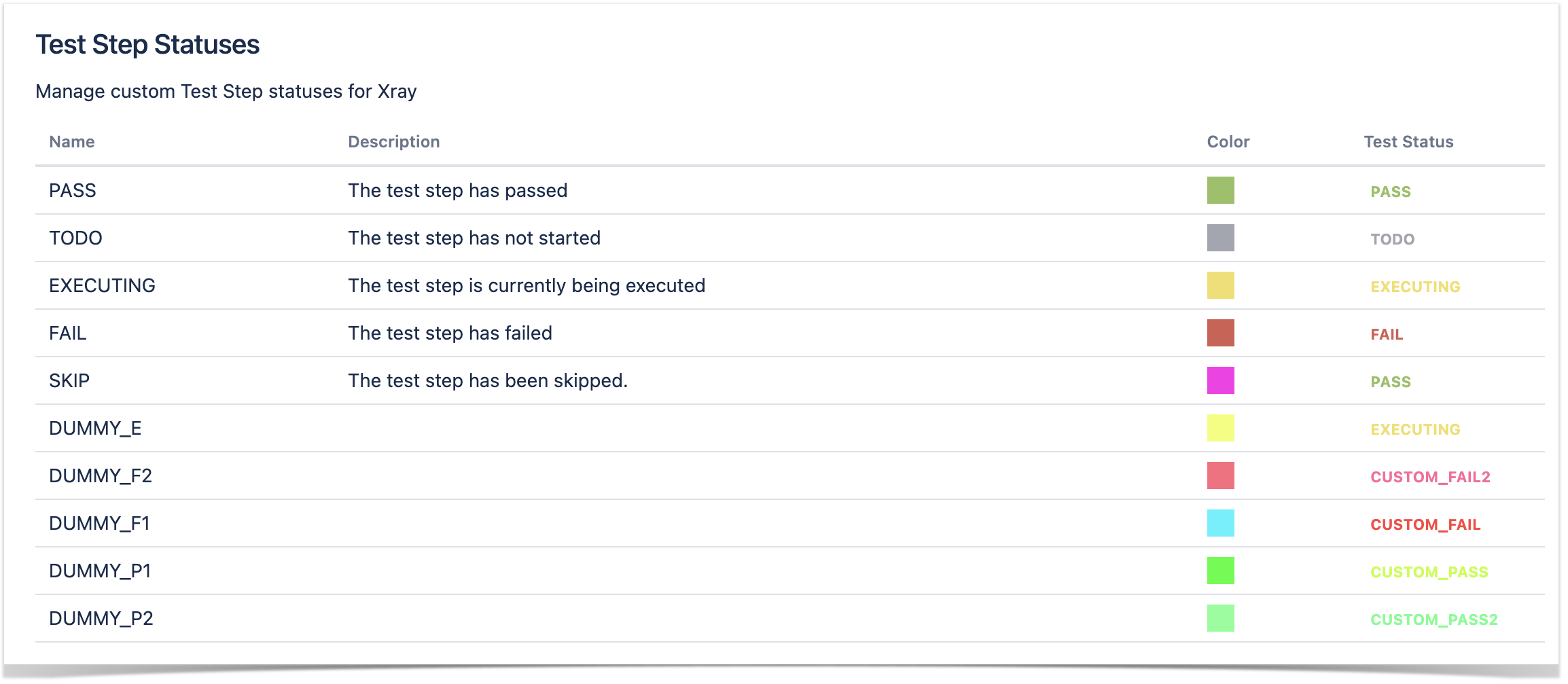
Example # | Statuses of the steps/contexts (the order of the steps/contexts is irrelevant) | Calculated value for the status of the Test Run | Why? |
|---|---|---|---|
| 1 |
| CUSTOM_PASS2 | We can see that both steps contribute in a "positive way" (i.e., they were successful as ultimately they are linked to successful coverage impact). Both statuses mapped to these test step statuses are associated with the "OK" coverage; as CUSTOM_PASS2 has higher ranking than CUSTOM_PASS, the run will be marked as "CUSTOM_PASS2". |
| 2 |
| CUSTOM_PASS2 | Similary to the previous example. Any status wins the "PASS" status. |
| 3 |
| CUSTOM_FAIL2 | We can see that both steps contribute in a "negative way" (i.e., they were not successful as ultimately they are linked to unsucessful coverage impact). Both statuses mapped to these test step statuses are associated with the "NOK" coverage; as CUSTOM_FAIL2 has higher ranking than CUSTOM_FAIL, the run will be marked as "CUSTOM_FAIL2". |
It is possible to calculate the status of a Test either by Version or Test Plan, in a specific Test Environment or globally, taking into account the results obtained for all Test Environments.
Analysis:
What affects the calculation:
The following table provides some examples given the Test Statuses configuration shown above in the Managing Test Statuses section.
Example # | Statuses of the Test Runs (ordered by time of execution/creation, ascending) | Final statuses have precedence over non-final statuses | Calculated value for the status of the Test | Why? |
|---|---|---|---|---|
| 1a |
| true | PASS | Latest executed Test Run (2) having a final status was PASS. |
| 1b |
| false | TODO | Latest created Test Run (3) was TODO. |
| 2a |
| true | MYPASS2 | Latest executed final Test Runs on each environment were PASS, MYPASS2 and PASS respectively. Since MYPASS2 (3) has higher ranking then the calculated status will be MYPASS2. |
| 2b |
| false | TODO | Latest created Test Runs on each environment were PASS, TODO and PASS respectively. Since PASS has the lowest ranking, then TODO (3) will "win" and then the calculated status will be TODO |
| 3 |
| true | TODO | Latest created Test Runs on each environment were PASS, TODO and PASS respectively. Although Test Environment "env2" has only a non-final Test Run, since there is no other Run for that environment, then it will be considered as the calculated status for that environment. Since PASS has the lowest ranking, then TODO (3) will "win" and then the calculated status will be TODO. |
| 4 |
| true (or false) | FAIL | Latest executed (or created) final Test Runs on each environment were PASS, FAIL and PASS respectively. Since the calculated status for one of the environments is FAIL, then the calculated status will be FAIL. |
| 5 |
| true | MYPASS2 | Latest executed final Test Runs on each environment were PASS, MYPASS2 and MYFAIL respectively. MYPASS2 has higher ranking than the other ones, thus the overall calculated value will be MYPASS2. |
| 6 |
| false | MYFAIL | Latest created Test Runs on each environment were PASS, TODO and MYFAIL respectively. MYFAIL has higher ranking than the other ones, thus the overall calculated value will be MYFAIL. |
It is possible to calculate the test coverage status of a coverable issue either by Version or Test Plan, in a specific Test Environment or globally, taking into account the results obtained for all Test Environments.
Analysis :
The algorithm is similar to the overall calculation of the Test status, taking into account the results obtained for different Test Environments.
In other words, the status for each linked and "relevant" Test case is calculated and at the end, a joint calculation is done for a virtual Test case. The coverage status will correspond to the mapped value for the status that was calculated for this virtual Test.
The Tests that will be considered as covering the issue are not just the ones directly linked to the issue. In fact, they may either be direct ones or ones linked to "child" issues (e.g., sub-requirements).
Algorithm :
What affects the calculation:
Indirectly, the flag "Final statuses have precedence over non-final statuses" (enabled by default)
The existence of Test Runs for different Test Environments, in case the analysis is made for "All Environments"
Test Coverage Hierarchy
Sometimes, you may have parent requirements and sub-requirements. In general, you may have parent issues and "child" issues, both of them being handled as coverable issues.
Xray is able to understand this hierarchical relation and takes that into account for the calculation of the coverage status of the parent issues.
When a issue has some "child" issues, then the calculated status for the parent issue depends not only on its status calculated per se but also on the status of each individual child.
The calculation follows the rules described in the following table.
PARENT \ CHILD | OK | NOK | NOT RUN | UNKNOWN | UNCOVERED |
|---|---|---|---|---|---|
| OK | OK | NOK | NOT RUN | UNKNOWN | OK |
| NOK | NOK | NOK | NOK | NOK | NOK |
| NOT RUN | NOT RUN | NOK | NOT RUN | UNKNOWN | NOT RUN |
| UNKNOWN | UNKNOWN | NOK | UNKNOWN | UNKNOWN | UNKNOWN |
| UNCOVERED | OK | NOK | NOT RUN | UNKNOWN | UNCOVERED |
From another perspective, you would obtain the same value for the calculation of the status of the parent issue if you consider that it is being covered by all the explicitly linked Tests and also the ones linked to the child issues.
Consequences :
The parent issue is OK if it is OK per se and the child issues are either UNCOVERED or also OK
The parent issue is NOK if it is NOK per se or if any of the child issues is NOK
The parent issue is only UNCOVERED if neither the parent requirement is covered per se nor the child issues are covered
Even if you are using the Test Coverage Hierarchy-related features, when you have tests that are directly linked to the parent issue, Xray assumes that you are validating the parent issue directly. Thus, it's irrelevant if the child issues are uncovered by tests or not.
Examples
The following table provides some examples given the Test Statuses configuration shown above in the Managing Test Statuses section.
Example # | Statuses of the related Tests (child issues, whenever present, appear as subReqX) | Calculated value for the coverage status of the issue | Why? |
|---|---|---|---|
| 1 |
| OK | All Tests are passed (it is similar to having just one virtual test that would be considered PASS and thus mapped to the OK status of the issue) |
| 2 |
| NOT RUN | One of the Tests (3) is TODO, which has higher ranking than PASS. |
| 3 |
| NOK | One of the Tests (3) is FAIL, which has higher ranking than PASS. |
| 4 |
| NOK | One of the Tests (3b) is FAIL, thus subReq2 will be considered as NOK. Since it is NOK, then the parent req which has higher ranking than PASS. |
| 5 |
| NOT RUN | One of the child issues (subReq1) is NOT RUN, thus the calculated status, whenever doing the conjunction with the parent issue status, will be NOT RUN. |
| 6 |
| OK | Since all child issues are uncovered and the parent issue is covered directly by one Test (1), which is currently PASS, then the calculated "OK" status will be based on that Test. |